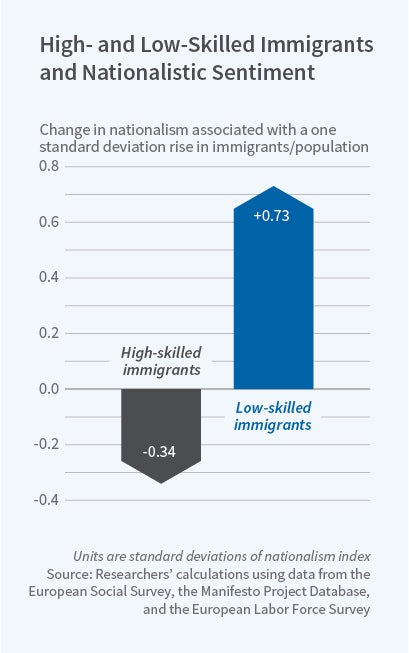Immigration and Nationalism: A Matter of Degrees?
Across a dozen European countries, an influx of less-educated immigrants fanned nationalism, while inflows of highly educated immigrants dampened it.
Recent elections in Europe and the United States demonstrate the growing strength of populist and nationalistic causes and politicians. One explanation of this development is deep voter anger at governmental policies with regard to immigrants, whom nationalists tend to view as poor, unskilled, and burdens on the national economy and budget.
In Skill of Immigrants and Vote of the Natives: Immigration and Nationalism in European Elections 2007-16 (NBER Working Paper No. 25077), Simone Moriconi, Giovanni Peri, and Riccardo Turati explore the relationship between immigration and European elections. They develop an index of "nationalistic" attitudes of political parties to measure the shift in preferences among voters when confronted with influxes of skilled and unskilled immigrants. They find that larger inflows of highly educated immigrants dampen nationalistic sentiments, while larger inflows of less-educated immigrants heighten them. Their results imply that a more balanced inflow of high-skilled and low-skilled immigrants could attenuate voters' nationalistic attitudes.
The economic, political, and cultural impact of immigration on European countries has been widely studied, with particular attention to how the education levels of native voters influence their voting preferences. The new study tracks voter attitudes and behavior for all political parties and elections in 12 European countries for a decade. It relies on demographic and political data from the European Social Survey and a number of other sources. In addition, the researchers collected and classified the political manifestos of 126 parties for 28 elections, focusing in particular on how frequently these materials mentioned nationalistic subjects, the European Union, and other indicators of where parties stood on the political spectrum. In effect, they created an "average nationalism score" that they could use to measure voting pattern deviations either toward or away from nationalism in reaction to immigrant inflows.
The analysis of voter attitudes with regard to nationalism finds that highly educated native voters are less nationalistic in their attitudes towards immigrants than less-educated natives. The data also show strong nationalistic sentiments in regional pockets in the United Kingdom, Ireland, France, Germany, Demark, Sweden, Norway and, especially, Italy.
The researchers address the potential effect of native nationalism on immigrant inflows in different skill groups by using the country-specific location of previous waves of immigrants to predict what the current skill composition of a nation's immigrant inflows would be if past patterns continued to hold. Then, they use variation in overall flows of immigrants, along with this predicted measure of skill composition, to create a measure of the skill composition of current inflows. They analyze how this measure was related to voting and voter preferences.
The results suggest that a 1 percent increase in the share of a country's population who are immigrants in highly educated, highly skilled groups was associated with a 0.1 standard deviation voting change away from nationalism. An increase of comparable size in the number of less-educated and lower-skilled immigrants led to a 0.12 standard deviation voting change towards nationalism. The same patterns emerged when the researchers analyzed voter sentiment expressed in surveys. In this case, a 1 percent increase in high-skilled immigrants led to a 0.07 standard deviation decrease away from nationalism, while a 1 percent increase in lower-skilled immigrants lead to a 0.07 standard deviation increase in nationalism. The results were broadly similar regardless of whether the analysis focused on all immigrants or only on immigrants from non-EU nations.
— Jay Fitzgerald



